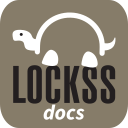1.2. LOCKSS Plugin Format#
A LOCKSS plugin is expressed as a mapping from keys to values. Except for rare exceptions that are built into the LOCKSS software, LOCKSS plugins consist of an XML file containing these key-value pairs, accompanied by optional Java class files (compiled Java code), bundled together in a JAR file (a Java-specific Zip file).
The XML format of the plugin is a single <map> element, containing any number of map entries expressed as <entry> elements. Each map entry is a key-value pair, namely a plugin key which must be the first child of the <entry> element and must be of type String, and a plugin value which must be the second child of the <entry> element. See the Plugin Value Types for more about possible plugin values.
The order of the key-value pairs does not matter. The effect of specifying multiple entries with the same key is undefined.
Example:
<map>
<!-- plugin key with string value -->
<entry>
<string>key_one</string>
<string>Lots Of Copies Keep Stuff Safe</string>
</entry>
<!-- plugin key with integer value -->
<entry>
<string>key_two</string>
<int>3000</int>
</entry>
<!-- plugin key with long integer value (e.g. number of milliseconds) -->
<entry>
<string>key_three</string>
<long>1209600000</long>
</entry>
<!-- plugin key with list value (e.g. list of strings) -->
<entry>
<string>key_four</string>
<list>
<string>List item one</string>
<string>List item two</string>
<string>List item three</string>
</list>
</entry>
<!-- plugin key with map value (e.g. mapping from string to string) -->
<entry>
<string>key_five</string>
<map>
<entry>
<string>subkey1</string>
<string>subvalue1</string>
</entry>
<entry>
<string>subkey2</string>
<string>subvalue2</string>
</entry>
<entry>
<string>subkey3</string>
<string>subvalue3</string>
</entry>
</map>
</entry>
</map>
1.2.1. Plugin Value Types#
Plugin values can be of the following types:
XML Element |
Plugin Value Type |
|---|---|
|
|
|
|
|
|
|
|
|
1.2.1.1. String#
- XML Element
<string>- Description
An arbitrary string of characters.
Because the plugin is expressed as XML, some characters in the string must be properly encoded:
&is encoded as&.<is encoded as<.>is encoded as>.Non-printable characters and characters outside the 7-bit ASCII set are encoded with numeric character references [1], either decimal character references (for example
éencoded aséoré) or hexadecimal character references (for exampleéencoded aséoréoréoré).
- Examples
<string>This is a string value</string> <string>Taylor & Francis</string> <string>Vive la différence !</string>
1.2.1.2. Integer#
- XML Element
<int>- Description
An integer value. Represented internally as a 32-bit integer.
- Example
<int>1234</int>
1.2.1.3. Long Integer#
- XML Element
<long>- Description
A long integer value. Represented internally as a 64-bit integer.
- Example
<long>5000000000</long>
1.2.1.4. List#
- XML Element
<list>- Description
A
<list>elements containing an ordered sequence of values (typically all of the same type).- Example
<!-- list of strings --> <list> <string>Item one</string> <string>Item two</string> <string>Item three</string> </list>
1.2.1.5. Map#
- XML Element
<map>- Description
A
<map>element containing an unordered sequence of map entries expressed as<entry>elements. Each map entry is a key-value pair; the key must be the first child of the<entry>element and must be a String, and the value must be the second child of the<entry>element.The effect of specifying the same key in more than one map entry is undefined.
- Example
<!-- mapping from string to string --> <map> <entry> <string>key1</string> <string>value1</string> </entry> <entry> <string>key2</string> <string>value2</string> </entry> <entry> <string>key3</string> <string>value3</string> </entry> </map>
Footnotes
